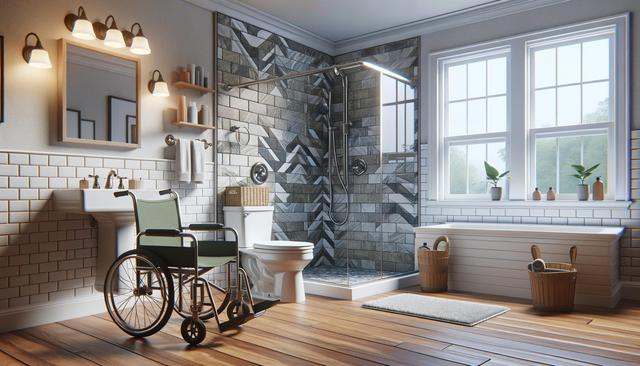Guide to Bathroom Remodel for Veterans
A bath redo can add style and fun. Change old tiles, add new sinks, or fix the tub. With smart picks, you can save on cost and get a fresh feel. A plan leads to great work.

Understanding Special Needs and Priorities
For many veterans, especially those with disabilities or mobility challenges, a bathroom remodel is more than just a visual upgrade — it’s a key step toward independence and comfort. The first step is identifying specific needs. Veterans with service-connected injuries may require accessible designs that accommodate wheelchairs or limited mobility. Key features to consider include walk-in tubs, grab bars, wider doorways, and non-slip flooring. These elements not only add safety but also enhance ease of use on a daily basis.
Before diving into the remodel, assess how the space is currently used and what changes could make it more supportive. Veterans with vision impairments, for example, may benefit from high-contrast color schemes and motion-sensor lighting. Meanwhile, those with hearing impairments might look into visual alert systems and quieter ventilation fans.
It’s essential to keep the future in mind. A remodel that anticipates changing needs — such as aging in place — offers long-term value. Planning for enhanced accessibility now can help reduce the need for further modifications down the line.
Finding Financial Support and Resources
One of the most important aspects of remodeling for veterans is understanding the financial assistance available. Several programs exist specifically to help with home modifications for service members. These resources can lighten the financial load and open up more possibilities for a functional and stylish remodel.
Here are a few key programs to explore:
- Specially Adapted Housing (SAH) Grant – Helps veterans with certain service-connected disabilities construct or modify a home for better accessibility.
- Home Improvements and Structural Alterations (HISA) – Supports both service-connected and non-service-connected veterans in making medically necessary changes.
- Veterans Directed Home and Community Based Services (VD-HCBS) – Offers more control over care and funding, including for home modifications.
Connecting with a local Veterans Affairs office or veteran service organization can provide personalized guidance. They can assist in the application process and help ensure that all available benefits are utilized.
Designing for Accessibility and Comfort
Once funding and needs are clear, the next step is design. A bathroom that balances accessibility with comfort and aesthetics can make a major difference in daily life. For veterans, it’s important to choose features that match their physical needs while also creating an inviting environment.
Popular accessible design elements include:
- Curbless or low-threshold showers with built-in seating
- Handheld showerheads and easy-to-reach controls
- Elevated toilet seats with side rails
- Lever-style faucets and door handles for easier grip
In addition to functionality, consider the atmosphere. Warm lighting, soothing colors, and quality finishes can contribute to well-being. Veterans who spend more time at home may especially appreciate a space that promotes relaxation.
Custom cabinetry can also be useful, offering storage solutions that are reachable without bending or stretching. Combining practical features with thoughtful design creates a bathroom that is both useful and enjoyable.
Selecting the Right Contractors and Materials
Choosing the right professionals to carry out a remodel is critical. Look for contractors who have experience with accessible remodeling projects, particularly those who understand the unique needs of veterans. Some may even specialize in VA-funded modifications and be familiar with the necessary paperwork and standards.
When selecting materials, durability and safety should be top priorities. Non-slip tiles, water-resistant paint, and mold-resistant drywall all help create a healthier, longer-lasting space. It’s also worth investing in quality fixtures that require minimal maintenance and offer ease of use.
Before finalizing any contract, ask for references and review similar past projects. A reliable contractor should be transparent, communicative, and respectful of your vision. Veterans may also want to involve occupational therapists in the process to ensure the remodel supports their physical requirements.
Good materials and a solid team can make a significant difference in both the outcome and the overall remodeling experience. Be sure to get multiple estimates and carefully compare them before making a decision.
Maintaining Your New Bathroom Over Time
Once the remodel is complete, maintenance ensures the bathroom continues to meet your needs for years to come. Veterans should create a simple upkeep routine that includes checking for leaks, cleaning ventilation systems, and ensuring safety features remain in good condition.
Some helpful maintenance tips include:
- Regularly inspect grab bars and handrails to ensure they remain securely attached
- Keep walkways and floor surfaces clean and dry to prevent slips
- Test lighting fixtures and motion sensors to confirm proper operation
- Clean and descale showerheads and faucets to maintain water flow
Consider scheduling professional inspections every few years, especially for plumbing and electrical systems. This helps catch small issues before they become costly repairs. Veterans who have made use of grants or VA-supported remodels should also keep records of all modifications and receipts in case future updates are needed.
With a little care and attention, a remodeled bathroom can remain safe, accessible, and comfortable for years to come, contributing positively to a veteran’s quality of life.
Conclusion: Empowering Veterans Through Better Spaces
Remodeling a bathroom for a veteran is more than a home improvement project — it’s a meaningful investment in independence, safety, and comfort. By understanding individual needs, using available financial resources, and working with skilled professionals, veterans can create a space that truly supports their lifestyle. Whether the goal is greater mobility, better functionality, or simply a more pleasant environment, thoughtful planning leads to lasting results. For veterans and their families, a well-designed bathroom can ease daily routines and enhance overall well-being.